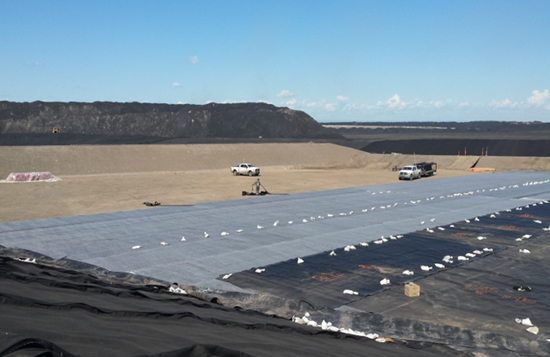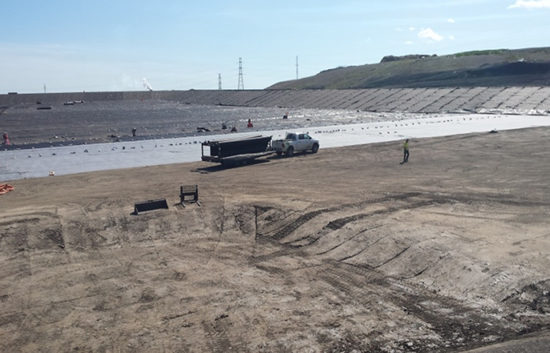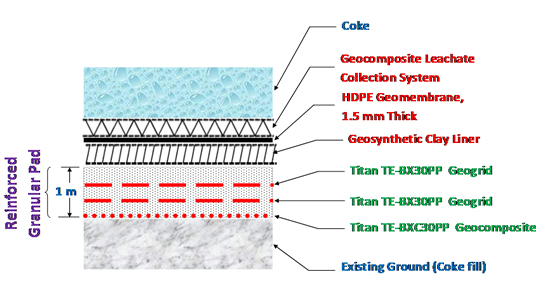


 By Jimmy Thomas and Sam Bhat – Upgrading bitumen from oil sands operations can produce a coke byproduct. In the case described here, it was a predominantly carbonaceous granular material which required environmentally sound disposal in a lined facility. It was known that the coke landfill needed an impervious geosynthetic barrier and a leachate collection system at the base; but deeper investigation revealed an elevated risk for differential settlement at the site.
By Jimmy Thomas and Sam Bhat – Upgrading bitumen from oil sands operations can produce a coke byproduct. In the case described here, it was a predominantly carbonaceous granular material which required environmentally sound disposal in a lined facility. It was known that the coke landfill needed an impervious geosynthetic barrier and a leachate collection system at the base; but deeper investigation revealed an elevated risk for differential settlement at the site.
As such, a reinforced soil pad was proposed.
SITE CONDITIONS
The ground at the site comprised a layer of coke fill with variable thickness and a deep deposit of clay. In view of the significantly high stresses imposed by the landfill and foundation strata comprising uncontrolled coke fill and thick clay layer, geotechnical considerations of stability and settlement and its impact on the long-term integrity of the lining system became important considerations in the design of the lining system.
The approved disposal area provided a 350 m x 140 m footprint and a maximum height of 30 m. With a slightly irregular shape to the cell, side slopes were at their steepest 3.3H:1V. Bore hole tests down to 41 m and groundwater analysis revealed varying thicknesses of coke fill and clay and a water table that was, at its highest point, 10 m from the site surface. At its lowest, the water table was 33 m.
Taking into account this information, including the medium to high plasticity of the clay, the bottom lining system was initially recommended to have a geosynthetic clay liner, a 60-mil high-density polyethylene (HDPE) geomembrane, and a geocomposite-based leachate collection system.
More detailed analysis, however, rooted in failure mechanisms, led to an alternative design.
FAILURE ANALYSIS
While all projects must account for the possible modes of failure and engineer against them, the coke landfill presented a few more challenges here than in conventional landfill work. The unique characteristics of the coke drove these concerns.
The project partners focused on failures such as foundation extrusion, bearing capacity failures, global stability, coke fill liquefaction, and excessive differential settlement of the lining system.
The design needed to prevent lateral plastic flow from beneath loaded areas, which meant that with a maximum height of 30 m and a coke unit weight of 1000 kg/m3, vertical stress at the base should be at a maximum 294 kPa. The clay consistency, which primarily ranged from very stiff to hard, put the expected undrained shear strength at 100 kPa or greater.
With a ratio of vertical stress to undrained shear strength less than 3, lateral squeeze would be highly unlikely.
The coke landfill bearing capacity was evaluated much as a flexible raft (again, 350 x 140 m) with no embedment below the ground surface.
The ultimate bearing capacity was estimated to be 835 kPa and with a 2.5 factor of safety of 2.5. The safe bearing capacity worked out to be 334 kPa. With the maximum vertical stress at the base calculated to be 295 kPa, and applied only in the center of the design, a bearing capacity failure was also determined to be highly unlikely.
Global stability was managed with the support of ReSSA (3.0) software. Calculations showed that the lowest factor of safety of 1.36 was obtained for relatively shallow slip surfaces passing through the coke (as would be expected for a slope comprising granular material for which effective cohesion is zero). Deep seated failure surfaces gave a factor of safety greater than 1.5. Thus, deep seated slip failures passing thorough the foundation strata were unlikely.
As for liquefaction, the upper-most foundation stratum for the coke landfill was a loose granular material, which was likely to densify during earthquake. The material was not saturated and the highest elevation of the ground water table was indicated to be below the bottom of this layer.
REINFORCING THE COKE LANDFILL
The main concern turned out to be differential settlement, and mitigating the risk required the addition of a geosynthetic reinforcement solution.
When settlement is uniform, stresses on a lining system are largely managed, but landfills tend to settle unevenly. The coke landfill liner system would tend to follow the settlement profile of the ground, and the ground was characterized by varying thicknesses of coke and clay. Designers were concerned with the overall system’s potential for settlement stresses.
The shape of the cell, with stress concentration in the center, provided confidence in the integrity of the GCL and HDPE geomembrane system to adapt to settlement, so long as the settlement was gradual. Abrupt, local changes in stresses needed to be prevented, which could otherwise damage the liner.
Here, a geosynthetic reinforcement solution was proposed.
The tensile support would span weak spots and voids, providing a check against settlement stresses. A reinforced soil pad below the lining system would function as this bridging layer and achieve a smoother settlement profile.
The reinforcement needed to supply approximately equal strength in both directions, have high tensile stiffness, and possess excellent chemical resistance within the coke landfill environment. Based on these considerations, a polypropylene geogrid with integral nodes was selected.
Adequate stiffness was achieved through the installation of a 1000 mm thick soil pad with three layers of reinforcement. The first layer was placed at the bottom of the pad, the second at a distance of 300 mm from the bottom, and the third at a distance of 600 mm from bottom. The bottom-most layer used a biaxial geogrid composite (TE-BXC30), which featured a continuous fiber nonwoven geotextile bonded to the geogrid. This provided a separation function within the same layer. The other layers used a biaxial geogrid (TE-BX30PP) with an ultimate tensile strength of 31 kN/m in both directions.
The final design gave all stakeholders confidence in the system, the coke landfill was constructed, and an environmentally smart solution gave the oil sands industry an approach that could consulted for future settlement-challenged installations.
**
Dr. Jimmy Thomas is the Senior Design Consultant and Sam Bhat is the VP Global Business Development & CTO Geosynthetics at Titan Environmental Containment Ltd, www.titanenviro.ca. NOTE: A longer, more technical version of this case was presented at GeoAmericas 2016 (10 – 13 April 2016, Miami). That version is available in the GeoAmericas 2016 proceedings.











